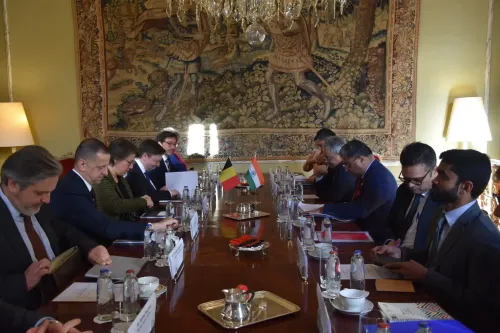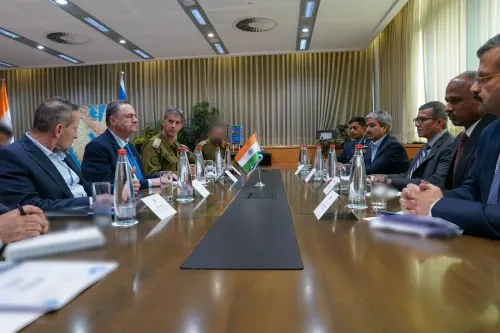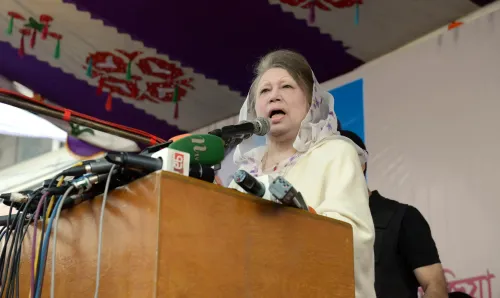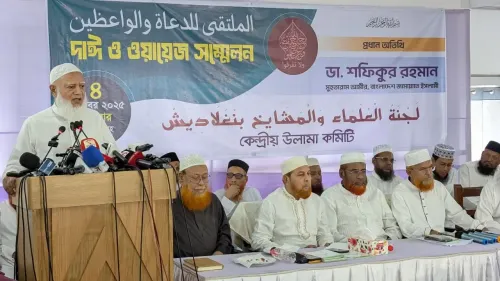Is Pakistan Stuck in an Endless Bailout Cycle?

Synopsis
Key Takeaways
- Pakistan is reliant on international bailouts.
- National assets are being sold off to maintain economic stability.
- Inflation rates are critically high, affecting everyday citizens.
- Political will for genuine reform remains lacking.
- The wealthy elite evade taxation, increasing the burden on the middle class.
New Delhi, Nov 2 (NationPress) Pakistan’s Finance Minister Muhammad Aurangzeb has emerged as one of the most active figures in the realm of global finance. One week he finds himself in Washington, advocating for yet another tranche of emergency funding from the International Monetary Fund (IMF); the next, he travels to Riyadh or Abu Dhabi, promoting the divestiture of national assets, including Pakistan International Airlines (PIA) and crucial energy infrastructure.
In many respects, Aurangzeb's role transcends that of a finance minister; he operates more like a broker of desperation, selling off the remaining vestiges of Pakistan’s economic sovereignty.
The country’s fiscal turmoil is not a new phenomenon, yet it remains perilously unresolved. Pakistan is no longer merely borrowing funds to maintain solvency; it is now being forced to liquidate its public sector remnants to ensure economic survival.
Despite numerous bailouts and reform pledges, the core issues plaguing Pakistan’s economic structure—such as entrenched elite capture, systemic inefficiency, and the military's substantial influence over financial matters—have largely gone unaddressed.
For over three years, Pakistan’s economy has teetered on the edge of default. In April 2022, the country narrowly sidestepped a sovereign debt crisis. Inflation reached a staggering 38 percent in May 2023, while foreign exchange reserves plummeted to $8.7 billion by February 2023.
Since that time, Islamabad has secured two IMF bailout packages, received multiple loan deferments from China, and negotiated deferred payment options for oil and gas from Gulf nations. However, these measures have merely extended the timeline without fostering genuine transformation.
The statistics paint a dire picture: Pakistan’s external debt has remained above $130 billion for over a year, and foreign exchange reserves are critically low, currently standing at approximately $19 billion, which can only cover about a month and a half of imports.
Inflation has fluctuated between 3 and 38 percent, severely diminishing the purchasing power of everyday Pakistanis. The rupee continues to depreciate, with 1 USD exceeding 285 PKR, while energy prices have skyrocketed, with petrol at PKR 265 per liter and diesel at PKR 275 per liter.
Furthermore, the unemployment rate is on the rise, currently estimated at around 8 percent, with nearly 40 percent of the population grappling with multidimensional poverty, according to the latest statistics from the UN Development Programme (UNDP).
However, what is particularly alarming is not just the severity of Pakistan’s economic struggles but the glaring lack of political will to implement reforms. Every IMF program since the 1980s has come with a familiar checklist—reducing subsidies, expanding the tax base, and enhancing fiscal transparency. Yet, each time, Pakistan has committed to compliance but consistently failed to move beyond mere policy rhetoric.
The current administration’s “reform agenda” under Prime Minister Shehbaz Sharif and Finance Minister Aurangzeb has proven to be no exception. While the notion of “structural transformation” is often echoed in speeches and communications, the reality remains superficial.
Consider the effort to broaden the country’s taxation base. Despite years of insistence from the IMF, Pakistan’s tax-to-GDP ratio stagnates at around 9 percent, one of the lowest rates in Asia.
The situation is further exacerbated by the fact that the affluent elite—comprising feudal landlords, industrial magnates, and military-linked conglomerates—have largely evaded the tax net. Consequently, the financial burden disproportionately affects the salaried middle class and consumers through indirect taxation.









